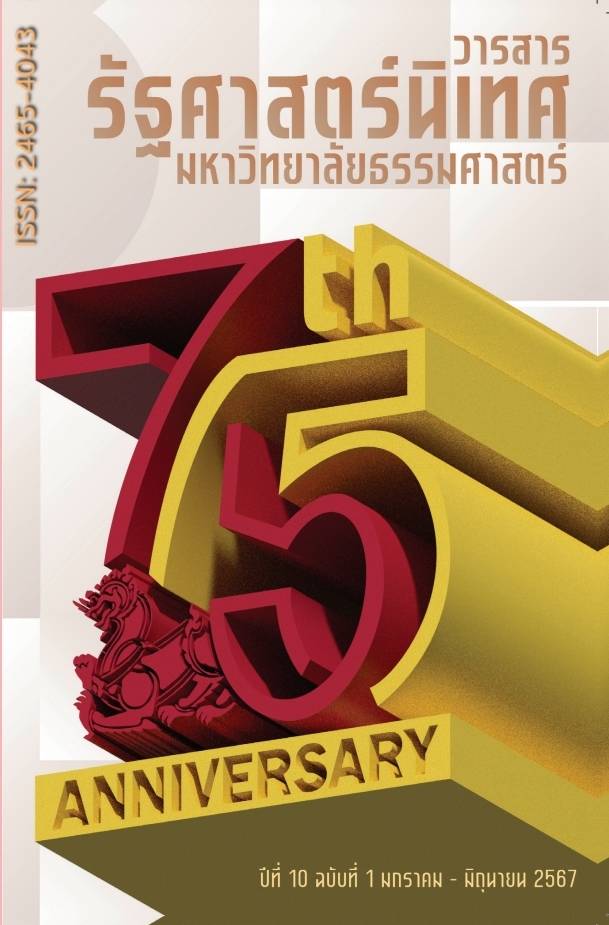การพัฒนาเศรษฐกิจสีน้ำเงินอย่างยั่งยืนในบริบทสากล
Main Article Content
บทคัดย่อ
“เศรษฐกิจสีน้ำเงิน” เป็นคำที่ได้รับความนิยมมากขึ้นเรื่อย ๆ ในเรื่องการบริหารจัดการทะเล ชายฝั่งและมหาสมุทรสมัยใหม่ แนวความคิดนี้มุ่งแสวงหาหนทางเพื่อการอยู่ร่วมกันได้ระหว่างโอกาสทั้งหลายในแง่การพัฒนากับการรักษาและให้ความสำคัญต่อสิ่งแวดล้อม บทความนี้นำเสนอการทบทวนเอกสารเกี่ยวกับแนวคิดและทิศทางการพัฒนาเศรษฐกิจสีน้ำเงิน และเลือกกรณีศึกษาในประเทศที่พัฒนาแล้ว (กลุ่มประเทศสหภาพยุโรป) ประเทศที่กำลังพัฒนา (ประเทศฟิลิปปินส์) และประเทศชายฝั่งที่มีการพัฒนาน้อยที่สุด (ประเทศบังกลาเทศ) เพื่อให้เห็นตัวอย่างของแนวทางและมาตรการการพัฒนาเศรษฐกิจสีน้ำเงิน การนำแนวคิดเศรษฐกิจสีน้ำเงินไปปฎิบัติของบริบทสากล แบ่งออกเป็นสามแนวทางหลัก ได้แก่ (1) ยุทธศาสตร์เศรษฐกิจสีน้ำเงินในเศรษฐกิจมหภาค (2) การพัฒนากรอบนโยบายทางเศรษฐกิจสีน้ำเงิน และ (3) การใช้เทคโนโลยีหรือนวัตกรรมในการจัดการเศรษฐกิจสีน้ำเงิน แนวทางการพัฒนาเศรษฐกิจสีน้ำเงินในสามประเด็นนี้ไม่ได้แยกขาดจากกันเสียทีเดียว แต่เชื่อมโยงและประสานองค์ความรู้เข้าด้วยกัน ในขณะที่ ทิศทางของการพัฒนาเศรษฐกิจสีน้ำเงินอย่างยั่งยืนที่จะมุ่งไปในอนาคตคือ ให้ความสำคัญกับการบรรลุเป้าหมายในการปล่อยคาร์บอนสุทธิเป็นศูนย์และความรับผิดชอบร่วมกันสำหรับมนุษย์ทุกคน ทั้งด้านเศรษฐกิจ และวิถีชีวิต รวมทั้งการต่อสู้กับวิกฤตการเปลี่ยนแปลงสภาพภูมิอากาศ การรักษาความหลากหลายทางชีวภาพและระบบนิเวศเพื่อนำไปสู่การพัฒนาภาคพื้นทะเลอย่างยั่งยืนในอนาคต
Article Details

อนุญาตภายใต้เงื่อนไข Creative Commons Attribution-NonCommercial-NoDerivatives 4.0 International License.
เอกสารอ้างอิง
หนังสือ
Cicin-Sain, Biliana, Knecht, Robert W., Jang, Dosoo and Fisk, Gregory W., Integrated Coastal and Ocean Management: Concepts and Practices, (Washington DC: Island Press, 1998), 72-80.
COWI Belgium, et. al., Blue Economy Roadmap, (Brussels: Oversea Countries and Territories Association, 2021), 98-155.
European Commission, Communication from the Commission to the European Parliament, the Council, The European Economic and Social Committee and the Committee of the Regions on a new Approach for a Sustainable Blue Economy in the EU Transforming the EU’ Blue Economy for a Sustainable Future, (Brussels: European Commission, 2021), 2-4.
European Commission, The EU Blue Economy Report 2022, (Luxembourg: Publications Office of the European Union, 2022), 74-81.
Mukit, Mushfiqul H., Blue Economy: A new economic frontier of Bangladesh, (New York: Pressenza, 2019), 1-9.
Partnership in Environmental Management for the Seas of East Asia, SDS-SEA Implementation Plan 2018-2022: Sustainable Development Strategy for the Seas of East Asia, (Quezon: Partnership in Environmental Management for the Seas of East Asia, 2018), 46-52.
Whisnant, R. and Reyes, A., Blue Economy for Business in East Asia, Towards an Integrated Understanding of Blue Economy, (Quezon: Partnership in Environmental Management for the Seas of East Asia, 2015), 16-17.
World Bank, THE POTENTIAL OF THE BLUE ECONOMY Increasing Long-term Benefits of the Sustainable Use of Marine Resources for Small Island Developing States and Coastal Least Developed Countries, (Washington DC.: The World Bank Groups, (2017).
นวรัตน์ ไกรพานนท์, “ ความตกลงระหว่างประเทศ นโยบาย และกฎหมายของประเทศไทยในการ ขับเคลื่อนเศรษฐกิจสีน้ำเงิน,” ใน พงษ์วิภา หล่อสมบูรณ์, วรรณพร สำราญรมย์, นัชธิกรณ์ สิทธิกัน และ เมธาพร ดีสุข (บก.), (ร่าง) รายงานเศรษฐกิจสีน้ำเงินแห่งชาติ ปี 2565 ด้านวิทยาศาสตร์ วิจัย และนวัตกรรม, (กรุงเทพฯ: สำนักงานคณะกรรมการส่งเสริมวิทยาศาสตร์ วิจัย และนวัตกรรม, 2566), 29-110
เผดิมศักดิ์ จารยะพันธุ์ และคณะ, คู่มือการดำเนินนโยบายเศรษฐกิจสีน้ำเงินของประเทศไทย, พิมพ์ครั้งที่ 1, (กรุงเทพฯ: สำนักงานกองทุนสนับสนุนการวิจัย, 2561).
วัชริน มีรอด และคณะ, การพัฒนากรอบการจัดทำระบบบัญชีเศรษฐกิจสีน้ำเงิน (SEEA Blue Economy ที่ เหมาะสมกับประเทศไทย รายงkoวิจัยฉบับสมบูรณ์, (กรุงเทพฯ: สำนักงานคณะกรรมการส่งเสริม วิทยาศาสตร์ วิจัย และนวัตกรรม, 2561).
โสภารัตน์ จารุสมบัติ, คู่มือการดำเนินนโยบายเศรษฐกิจสีน้ำเงินของประเทศไทย, (กรุงเทพฯ: สำนักงาน กองทุนสนับสนุนการวิจัย, 2562).
อุดมศักดิ์ ศีลประชาวงศ์ และคณะ, การจัดทำบัญชีประชาชาติด้านเศรษฐกิจทางทะเลและชายฝั่งสำหรับ ประเทศไทย รายงานวิจัยฉบับสมบูรณ์, (กรุงเทพฯ: สำนักงานคณะกรรมการส่งเสริมวิทยาศาสตร์ วิจัยและนวัตกรรม, 2563).
บทความ
Joyanta, Bir, et al., “A review on Blue Economy in Bangladesh: prospects and challenges,” International Journal of Natural and Social Sciences, Vol. 7, No. 4 (October 2020), 21-29.
Guerrerio, Jose, “The Blue Growth Challenges to Maritime Governance,” Frontier in Marine Science, Vol. 8, (2021), 14-26.
Lee, Ki-Hoon, Noh, Junsung and Khim, Jong Seong, “The Blue Economy and the United Nations’ sustainable development goals: Challenges and opportunities,” Environment International, Vol. 137, No. 105528 (January 2020).
Wenhai, Lu, et al., “Successful Blue Economy Examples with an Emphasis on International Perspectives,” Frontiers in Marine Science, Vol. 6, No. 261 (June 2019).
Wenhai, Lu, et al., “Successful Blue Economy Examples with an Emphasis on International Perspectives,” Frontiers in Marine Science, Vol. 6, No. 261 (June 2019), 25-32.
Hussain, M. Gulam, Failler, Pierre, Karim, A. Al and Alam, M. Khurshed, “Review on opportunities, constraints and challenges of blue economy,” Journal of Fisheries and Life Science, Vol. 2, No. 1 (July 2017), 15-28.
Voyer, Michelle et al., “Shades of blue: what do competing interpretations of the Blue Economy mean for oceans governance?,” Journal of Environmental Policy & Planning, Vol. 20, No. 5 (2018), 595- 616.
Park, Kwang Seo and Kildow, Judith T., “Rebuilding the Classification System of the Ocean Economy,” Journal of Ocean and Coastal Economics, Vol. 2014, No. 1 (December 2014), 11-18.
Koondee, Phongsathon, Sharafuddin, Mohammed Ali and Madhavan, Meena, “Blue economy: The past and present from the world and future directions for Thailand,” Maritime Technology and Research, Vol. 4, No. 2 (January 2022).
Azanza, Rhodora V., et al., “A Sustainable and Inclusive Blue Economy for the Philippines Archipelago,” Transactions National Academy of Science and Technology Philippines, Vol. 44, (2022), 221-230.
Mendoza, Ronald U. and Valenzuela, Sheena A., “Growing the Philippines’s Blue Economy Policy Challenges and Opportunities,” Transactions National Academy of Science and Technology Philippines, Vol. 39, No. 2 (2017), 241-261.
Martínez Vázquez, Rosa María, Milán García, Juan and de Pablo Valenciano, Jaime, “Challenges of the Blue Economy: evidence and research trends,” Environmental Science Europe, Vol. 33, No. 61 (May 2021).
Kaczynski, Woldzimierz W., “The Future of Blue Economy: Lessons for European Union,” Foundations of Management, Vol. 3, No. 1 (2011), 55-87.
ออนไลน์
ออนไลน์
Ebarva, Maria C., “Blue Economy Initiatives in the East Asian Seas,” PEMSEA (website), https://www.pemsea.org/ (accessed 21 March 2022).
Kamruzzaman, Mohammad. “Blue Economy, The Way To Sustainable Development Of Bangladesh And Its' Challenges and Constraints” Academia (website), https://www.academia.edu/40672725/Blue_Economy_The_Way_to_Sustainable_Development_o f_Bangladesh_and_Its_Challenges_and_Constraints (accessed 18 July 2022).
Tanhua, Toste, et al., “Nourishing Blue Economy and Sharing Ocean Knowledge; Ocean Information for Sustainable Development,” EuroSea (website) https://eurosea.eu/ download/outputs_and_reports/Horizon-Results-Booster-Policy-Brief-Ocean-Knowledge- September-2021.pdf (accessed 5 November 2021).
Dale, Trine, Cusack, Caroline and Ruiz, Manuel, “Aquaculture site selection Report,” AtlantOS (website) https://oceanrep.geomar.de/id/eprint/39456/ (accessed 22 January 2022).
United Nations Environment Programme, “Greening the Blue Report 2023,” UN environment programme (Website), https://wedocs.unep.org/bitstream/handle/20.50 0.11822/41373/Greening_the_blue_2022.pdf?sequence=3&isAllowed=y (accessed 14 March 2022).
United Nations, “Blue Economy Definitions,” United Nations (website) https://www.un.org/regularprocess/sites/www.un.org.regularprocess/files/rok_part_2.pdf (accessed 2 June 2021).


